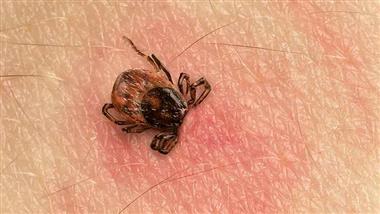by Dr. Joseph Mercola, Mercola:

STORY AT-A-GLANCE
- In her book, “Bitten: The Secret History of Lyme Disease and Biological Weapons,” Kris Newby reviews the circumstantial evidence suggesting the organism that causes Lyme disease may originally have been developed as a biological weapon
- An estimated 476,000 Americans are diagnosed with and treated for Lyme disease each year, and prevalence is rising
TRUTH LIVES on at https://sgtreport.tv/
- Lyme disease is transmitted by ticks (and sometimes other biting insects) infected with the bacteria Borrelia burgdorferi. There are about two dozen species of B. burgdorferi with hundreds of strains worldwide, many of which are resistant to antibiotics
- Ticks can also carry other pathogens, and coinfections are another reason why Lyme disease is so difficult to treat
- A major challenge with Lyme disease is that its symptoms imitate so many other disorders, including multiple sclerosis (MS), arthritis, chronic fatigue syndrome, fibromyalgia and even Alzheimer’s disease, making proper identification difficult and time consuming
In a February 28, 2023, Substack article,1 investigative journalist Paul D. Thacker interviewed award-winning author Kris Newby about the U.S. government’s history of manipulating pathogens to make them deadlier, and the secretive federal research that may be responsible for the epidemic of Lyme disease.
Newby, who educates health care providers on vector-borne diseases, is the author of “Bitten: The Secret History of Lyme Disease and Biological Weapons.” She also produced the 2008 Lyme disease documentary “Under Our Skin,”2 which was nominated for an Academy Award the following year.3 A follow-up film, “Under Our Skin 2: Emergence” came out in 2014.
As is the case with many people who end up becoming experts at a particular disease, Newby and her husband contracted Lyme disease in 2002 during a vacation at Martha’s Vineyard. “We were desperately ill and undiagnosed for a year. I thought that was the end of my life as I knew it. It took us four or five years to fully recover,” she told Thacker.
Background on Lyme Disease
According to the U.S. Centers for Disease Control and Prevention, an estimated 476,000 Americans are diagnosed with and treated for Lyme disease each year.4 While exact numbers are difficult to ascertain, what is known is that the prevalence is rising, and this is true across the world. Outbreaks are also steadily creeping into northern areas with less temperate climates.5
Lyme disease is transmitted by ticks (and sometimes other biting insects) infected with the bacteria Borrelia burgdorferi. There are about two dozen species of B. burgdorferi with hundreds of strains worldwide,6 many of which are resistant to antibiotics. Research7 suggests one reason for this may be that B. burgdorferi form protective biofilms around themselves, which enhances antibiotic resistance.
Another feature that makes B. burgdorferi such a formidable foe is its ability to take on different forms in your body, depending on the conditions. This clever maneuvering helps it to hide and survive. Its corkscrew-shaped form also allows it to burrow into and hide in a variety of your body’s tissues, which is why it causes such wide-ranging multisystem involvement.
Ticks can also carry other pathogens, and coinfections are another reason why Lyme disease is so difficult to treat, as the symptomology can be all over the place. Coinfections in many cases also don’t respond to treatment for B. burgdorferi, so a multilayered approach is frequently required to get all of the infections under control.
Lyme Disease Is Often Debilitating
A “typical” case usually starts out with an expanding rash, fever, fatigue, chills and headache. As the disease progresses, additional symptoms such as muscle spasms, loss of motor coordination, arthritic pain, debilitating fatigue, heart problems, psychiatric symptoms, cognitive difficulties, and problems with vision and hearing can emerge.8
For more information on identifying a Lyme disease rash, see the American Lyme Disease Foundation’s (ALDF) website.9 Newby describes her personal experience:
“It’s sort of like having multiple sclerosis, Alzheimer’s, chronic fatigue … joint pain, all at the same time. It’s primarily a neurological disease that creates hyper-inflammation in your body. And the symptoms commonly move around your body. You can be very debilitated, unable to perform the tasks of a normal adult …
There is a growing body of scientific evidence that shows that the Lyme disease bacterium is a trickster that is good at dodging your immune system.
It comes out of the tick in a very mobile spirochetal form and, when it senses an antibiotic or killer cells, it goes into a dormant cyst form, hiding out for months to years. And when your immune system is stressed, it can start causing disease again.”
A major challenge with Lyme disease is that its symptoms imitate so many other disorders, including multiple sclerosis (MS), arthritis, chronic fatigue syndrome, fibromyalgia and even Alzheimer’s disease, making proper identification difficult and time consuming.10
What’s worse, many Lyme sufferers outwardly look quite healthy, and their blood work often raises no cause for concern, which is why Lyme disease has also been called “the invisible illness.”
In the past, Lyme sufferers were frequently told that their problem was psychiatric; in essence, the symptoms were “all in their head.” Today, Lyme is becoming more widely recognized as an actual disease, but sufferers are still often met with skepticism and resistance from the medical community and insurers.




